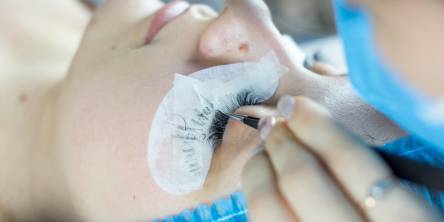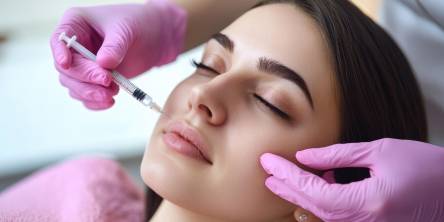The Science Behind Lash Glue: What Every Lash Artist Should Know

Quality lash adhesive is key to ensuring long-lasting, flawless lash extension results. As a lash artist, understanding the science behind lash glue, its components, and the different types of adhesives available is essential for providing your clients with a safe, effective, and professional lash extension service. Here’s an in-depth look at everything you need to know about lash glue to elevate your skills and ensure optimal results for your clients.
What Makes Lash Glue Effective? Key Ingredients and Formulas
Lash glue, also known as eyelash extension adhesive, is a specialized formula designed to bond synthetic lash extensions to a client’s natural lashes. The effectiveness of the adhesive depends largely on its key ingredients, which are formulated to create a strong, long-lasting bond without causing irritation.
The primary ingredient in most lash glues is cyanoacrylate, a fast-bonding compound that polymerizes when exposed to moisture, creating a powerful, durable hold. Ethyl cyanoacrylate is the most common version used in lash adhesives because of its quick-drying nature and strong bonding capabilities.
In addition to cyanoacrylate, other ingredients such as acrylic acid, methacrylate, and carbon black may be present, each contributing to the glue’s performance, flexibility, and drying speed. The ratio of these ingredients influences the adhesive’s drying time, bond strength, and flexibility.
Understanding these ingredients is critical because, as a lash artist, choosing the right adhesive based on a client’s needs is a fundamental part of your craft. For example, if a client is sensitive to certain chemicals, a different glue may be required.
Types of Lash Adhesives and How to Choose by Humidity and Speed
Not all lash glues are created equal, and selecting the right adhesive for different conditions is essential for achieving optimal retention and results. The choice of adhesive largely depends on the environment in which you work, especially humidity and drying time.
Fast Drying Lash Glue: For professionals who work quickly or with clients who have a high number of natural lashes, fast-drying lash glue is essential. This type of glue dries in under 2 seconds, allowing for swift application of extensions and preventing the glue from becoming too sticky during the application process. However, these adhesives are sensitive to environmental factors, particularly humidity. Fast-drying glue is ideal in high-humidity environments because it can cure quickly without causing an excessive amount of glue to remain in the air or on the client’s natural lashes.
Humidity-Specific Lash Glue: Lash adhesives are also formulated to react differently based on humidity levels. In high-humidity settings (above 60%), adhesives that are designed for high moisture levels will bond more effectively. These adhesives are formulated to resist humidity-induced breakdown while maintaining their performance. On the other hand, in low-humidity settings, glues that require a lower moisture content will work best. Using the wrong adhesive in the wrong humidity conditions can cause the glue to cure too slowly or too quickly, resulting in poor lash retention.
Best Lash Glue for Extensions: When choosing the best professional lash glue, it’s important to look for products that suit the type of lashes you apply, your speed of application, and the environmental conditions you work in. The best lash glue will offer a balance between long-lasting hold, flexible drying times, and safety for both the client and the lash artist.
Safety Tips and Allergy Considerations
As a professional lash artist, safety should always be your top priority. One of the key concerns with lash adhesives is the risk of allergic reactions. Some clients may be sensitive to the ingredients in eyelash extension glue, leading to irritation, swelling, or even more severe reactions such as conjunctivitis or dermatitis.
It’s important to test for allergic reactions before applying lash extensions. Many lash artists use a patch test, where a a couple of lashes are attached to the outer corner of the eye to see if irritation occurs. Patch tests should always be done 24 to 48 hours prior to the full treatment.
Using milder lash glue is a great way to minimize the risk of allergic reactions. These adhesives are free from harsh chemicals like formaldehyde and are formulated for clients with more sensitive eyes.
Common Mistakes That Reduce Retention
While lash glue is designed to create a strong bond, several common mistakes can reduce its effectiveness and cause premature shedding of the extensions.
Excess glue application: Overapplying adhesive can result in lashes sticking together or heavy clumping, which not only looks unnatural but also compromises retention.
Incorrect curing time: Not allowing the adhesive enough time to cure before exposing the lashes to moisture (e.g., showering or sweating) can weaken the bond.
Improper cleaning: Failing to properly clean the natural lashes before application can cause debris or oils to interfere with the glue’s bond, leading to quicker lash loss.
By avoiding these mistakes and ensuring precise application and curing, you can extend the longevity of your client’s lashes and provide them with a beautiful, long-lasting look.
Proper Storage and Shelf Life of Lash Adhesives
Lash adhesives are sensitive to both heat and air exposure. Improper storage can lead to thickening or clumping of the glue, making it ineffective and unsafe for use. To prolong the shelf life of your lash glue, it should be stored in a cool, dry place, away from direct sunlight, and tightly sealed to prevent exposure to air. Most adhesives will last around 3-6 months, depending on the manufacturer’s instructions.
Before using any adhesive, make sure to check its expiration date. Using expired glue can result in poor retention and an increased risk of irritation for your clients.
Best Professional Lash Glues for Different Skill Levels
Selecting the right adhesive also depends on your experience level as a lash artist. For beginners, a slower-drying adhesive with a bit more flexibility may be the best option, as it allows more time for adjustments. On the other hand, more experienced lash artists may prefer fast-drying glue to speed up the process and reduce the amount of time the glue is exposed to air.
For advanced artists working in higher humidity, a strong-hold adhesive designed to perform in moist conditions will yield the best results. Additionally, for those who specialize in volume lashes, a high-viscosity glue may provide better bonding for the multiple lashes applied at once.
Conclusion
Understanding the science behind lash glue is crucial for ensuring that your clients receive high-quality, long-lasting eyelash extensions. By selecting the right glue for the job, adhering to safety standards, and avoiding common mistakes, you can elevate your lash artistry and provide your clients with stunning results. Always invest in professional-grade lash adhesives that suit your working environment, and stay informed about new innovations in lash glue technology to stay ahead in the industry.
Similar Articles
Make your travel photos stand out with simple eye and lash enhancements that fix fatigue and harsh lighting. Capture vibrant, natural, frame-worthy vacation shots.
Boost your daily glow with hydrating foundation. Learn how it smooths lines, blends easily, and keeps skin fresh, soft, and radiant all day.
Learn what to expect from a cosmetic consultation, including safety checks, skin analysis, treatment options, and smart questions to ask before deciding.
Learn how Botox goes beyond beauty—relieving migraines, muscle spasms, and more while boosting confidence and wellness.
Discover how essential vitamins support skin repair, boost renewal, and enhance resilience through diet, skincare routines, and science-backed practices.
Struggling with back hair removal? Discover why electrolysis offers permanent results, precision, and smoother skin compared to other methods.
Choosing the right piercing can feel tricky with so many styles out there.
Discover 2025's beauty trends: sustainability, AI personalization, inclusivity, skinimalism, and at-home spa tech. Revolutionizing self-care with innovation!
Are you searching for the secret behind youthful, glowing skin? The path to glowing skin can sometimes be daunting, as there seems to be an endless array of miracle products promising unbelievable results









